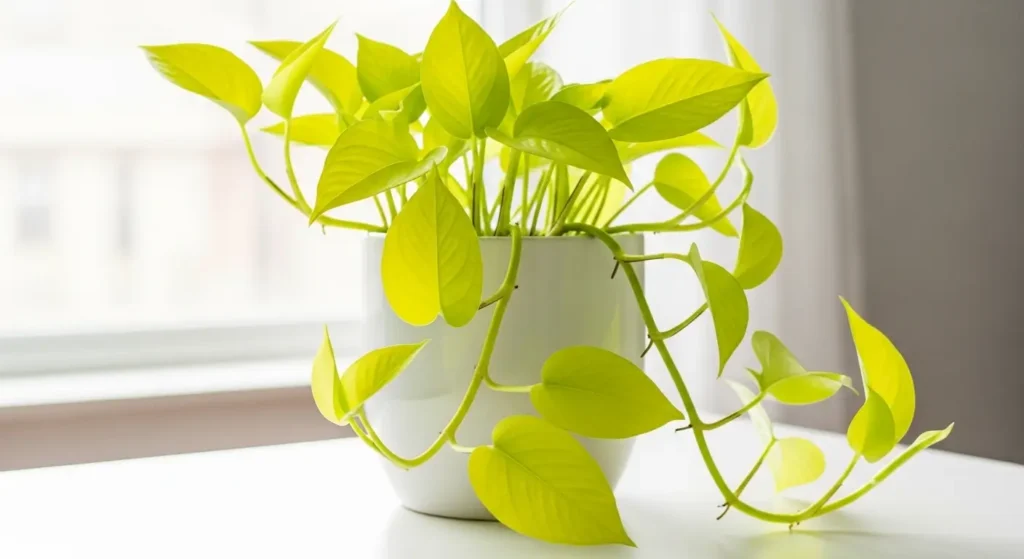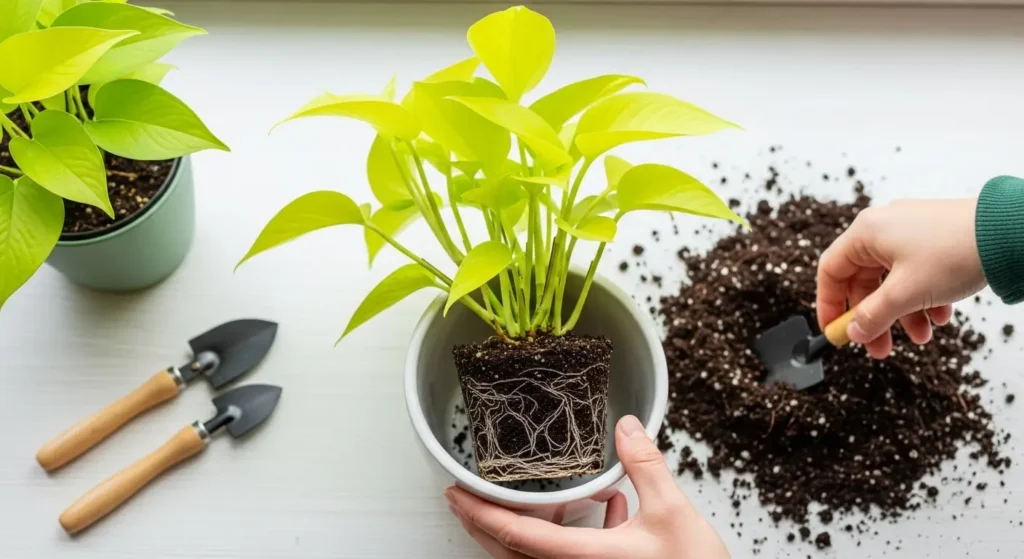
In This Article
The neon pothos (Epipremnum aureum ‘Neon’) is a stunning tropical houseplant that instantly brightens any room with its electric lime-green foliage. Unlike its darker-leafed cousins, this variety boasts vibrant chartreuse leaves that practically glow under the right lighting. Native to the Solomon Islands, this trailing vine has become a favorite among indoor plant enthusiasts. Honestly, it’s one of the easiest plants you can grow indoors, making it perfect for beginners and busy plant parents alike.
Neon Pothos Plant Care Card
| Plant Information | Details |
|---|---|
| Common Name | Neon Pothos, Golden Pothos ‘Neon’ |
| Botanical Name | Epipremnum aureum ‘Neon’ |
| Family | Araceae |
| Plant Type | Perennial, tropical vine |
| Mature Size | 6-10 feet long (indoors) |
| Sun Exposure | Bright indirect light |
| Soil Type | Well-draining potting mix |
| Soil pH | 6.1-6.5 (slightly acidic) |
| Hardiness Zones | 10-12 (USDA) |
| Native Area | Solomon Islands |
| Toxicity | Toxic to cats, dogs, and humans |
Neon Pothos Care
Neon pothos is a relatively low-maintenance plant that adapts well to most indoor conditions. Here’s everything you need to know about light, water, soil, and more to keep it thriving. With just a little attention, you’ll have a healthy, happy plant.
Light
Neon pothos thrives in bright indirect light, which keeps those leaves glowing that gorgeous chartreuse color. Too much direct sunlight will scorch the foliage and cause it to fade. On the other hand, insufficient light will make the leaves lose their vibrant neon glow and turn darker green.
For best results, place your plant near an east or north-facing window where it gets plenty of filtered light. If you only have south or west-facing windows, position it a few feet back or use a sheer curtain to diffuse the rays.
Soil
This plant needs a well-draining potting mix that holds some moisture but doesn’t stay soggy. According to the University of Maryland Extension on houseplant potting, most houseplants require proper drainage to prevent root rot issues. A standard houseplant potting soil works perfectly fine for most situations.
If you want to create your own mix, combine equal parts peat moss, perlite, and potting soil in a 1:1:1 ratio. You can add a handful of orchid bark to improve drainage further.
Water
Water your neon pothos when the top 2-3 inches of soil feel dry to the touch. These plants prefer to dry out slightly between waterings rather than sitting in constantly moist soil. Overwatering leads to yellow leaves and mushy stems, while underwatering causes drooping and brown edges.
During spring and summer when the plant is actively growing, you’ll likely water once every 7-10 days. However, in fall and winter, reduce watering to every 10-14 days. Always water thoroughly until it drains from the bottom holes, then discard excess water. Similar watering needs apply to Spider Plant care, another beginner-friendly houseplant.
Temperature and Humidity
Neon pothos prefers temperatures between 65-85°F, which basically covers normal household conditions. These plants can tolerate slightly cooler temps but will suffer if exposed to anything below 50°F. Keep your plant away from cold drafts and heating vents that blast air directly onto the foliage.
As for humidity, they’re surprisingly adaptable and do fine in average household levels. They’ll grow more vigorously in higher humidity, so feel free to mist occasionally or group with other plants.
Fertilizer
Feed your neon pothos with a balanced liquid fertilizer diluted to half strength every 2-4 weeks during spring and summer. The University of Maryland Extension recommends fertilizing indoor plants during active growth periods while reducing or stopping fertilization during winter months when reduced light and temperature result in slower growth. However, during fall and winter, reduce feeding to once every 6-8 weeks or stop altogether.
Propagating Neon Pothos
The best time to propagate is during spring and summer when the plant is actively growing. Propagation is super easy and one of the most satisfying plant activities.
Propagating by Stem Cuttings in Water

This is the easiest and most popular method for beginners.
Materials needed:
- Clean, sharp scissors or pruning shears
- Glass jar or vase with room-temperature water
- Healthy neon pothos plant
Step 1: Select a healthy stem that’s at least 4-6 inches long with 3-4 leaves. Make your cut just below a node, which is the little bump where leaves emerge.
Step 2: Remove the bottom 1-2 leaves so you have a clean stem to submerge, leaving at least 2 leaves at the top. Place the cutting in water, making sure one node is underwater.
Step 3: Put the container in bright indirect light and change the water every 3-5 days. Within 1-2 weeks, you’ll see tiny white roots sprouting from the nodes.
Step 4: Once roots reach 2-3 inches long (after 3-4 weeks), pot the cutting in soil or keep it growing in water. Many plant parents prefer keeping pothos in water long-term.
Propagating by Stem Cuttings in Soil
This method skips the water stage and puts cuttings directly into soil.
Step 1: Take a 4-6 inch cutting with 3-4 leaves, making your cut below a node. Remove the lower leaves as before.
Step 2: Dip the cut end in rooting hormone (optional), then insert about 2 inches deep into moist potting mix.
Step 3: Water lightly, then cover with a plastic bag to create a humidity dome. Place in bright indirect light and keep soil moist but not waterlogged.
Roots develop within 2-3 weeks, and you’ll know it’s rooted when you see new leaf growth.
Potting and Repotting Neon Pothos

Repot your neon pothos every 1-2 years or when you notice roots growing out of drainage holes. Spring is the ideal time since the plant recovers quickly. If growth has slowed or water drains too quickly, it’s time for a new home.
Choose a pot only 1-2 inches larger than the current one. Make sure it has drainage holes at the bottom. Gently loosen the root ball, trim any dead roots, then place in the new pot with fresh mix. Water thoroughly after repotting and keep in shade for a week while it adjusts.
Common Pests and Diseases
Like most houseplants, neon pothos can occasionally attract pests, though they’re generally quite resistant. The Iowa State University Extension provides guidance on diagnosing and managing common houseplant pests early while populations are small.
Spider Mites
Look for fine webbing between leaves and tiny dots on undersides. Treat with insecticidal soap or neem oil every 3-4 days, and increase humidity around the plant.
Mealybugs
These appear as small white cottony masses in leaf axils and stems. Remove with rubbing alcohol on a cotton swab, or spray with neem oil weekly.
Scale Insects
Scale looks like small brown bumps on stems and leaves. Scrape them off manually or use horticultural oil spray weekly for 3-4 weeks.
Aphids
Tiny green or black insects cluster on new growth. Rinse with water or treat with insecticidal soap every few days until eliminated.
Common Problems with Neon Pothos
Here’s how to troubleshoot common issues:
Yellow Leaves
Yellow leaves usually signal overwatering issues where soil stays too wet, suffocating roots. However, they can also indicate nutrient deficiency if you haven’t fertilized in months. Natural aging causes only oldest bottom leaves to yellow.
Cut back on watering frequency and check drainage holes. If you suspect nutrients, start a regular fertilizing schedule. For naturally aging leaves, simply snip them off. Just like with Lipstick Plant care, proper watering makes all the difference.
Brown Leaves or Brown Leaf Tips
Brown tips usually point to low humidity, fluoride in tap water, or inconsistent watering. If entire leaves turn brown, you’re likely underwatering or the plant is getting scorched by direct sunlight.
Increase humidity by misting or using a pebble tray, and switch to filtered water. Make sure you’re watering consistently when the top inches of soil are dry. Move away from harsh sunlight.
Drooping or Wilting Leaves
Drooping leaves cry out for water, though occasionally they droop from overwatering too. If soil is bone dry, water thoroughly and your plant should perk up within 24 hours. If soil is soggy, you’ve got root rot developing.
For underwatered plants, establish a consistent schedule. For overwatered ones, let soil dry completely before watering again. Similar issues occur with Wandering Jew plant care when watering isn’t consistent.
Leggy Growth or Sparse Foliage
Insufficient light causes leggy, stretched-out growth with wide spacing between leaves. Your plant is reaching toward whatever light it can find. The vibrant neon color also fades when light is too low.
Move your plant to a brighter location immediately. You can prune back leggy vines to encourage bushier growth, and those cuttings make perfect propagation material.
FAQ
Do neon pothos need sunlight?
Yes, they need bright indirect sunlight to maintain vibrant color. Direct sun burns leaves, so avoid harsh afternoon rays. East or north windows provide perfect filtered light.
Are neon pothos fast growing?
Yes, they grow quickly under ideal conditions, adding 12-18 inches yearly. With proper light and fertilizer, new leaves unfurl every few weeks during spring and summer.
How do you take care of a neon pothos plant?
Provide bright indirect light, water when top 2-3 inches are dry, and use well-draining soil. Feed every 2-4 weeks in growing season. Keep temperatures between 65-85°F and away from drafts.
What’s the difference between neon and golden pothos?
Neon has solid chartreuse-green leaves that glow, while golden has darker leaves with yellow variegation. Neon requires brighter light to maintain color. Both share identical care requirements.

5 thoughts on “How to Grow and Care for Neon Pothos: Ultimate Guide”
Comments are closed.